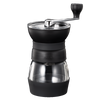Guest article by Jon Dempsey
To coffee lovers and geeks alike, the historic brand HARIO has an almost instant recognition and reputation. And even if you’re unfamiliar, you’ve probably been within arms reach of a HARIO product before: these coffee gadgets can be found in almost any neighbourhood cafe worth their salt.
For many, HARIO products were an entry point into specialty coffee, with their brewing gear laying the foundation for pour overs to be enjoyed and fussed over at home. Trust me, a HARIO product has likely been in the frame of a YouTube cooking video you saw, kitchen counter of a foodie friend or relative, or on the retail shelf of your local specialty coffee shop.
My history with HARIO dates back to 2009 when I first purchased the now iconic V60 cone dripper. I had just gotten into making pour-overs through befriending the zany owner of Halifax’s first third-wave cafe, Two If By Sea. It was there that I first experienced staggeringly tasty “specialty” coffee. He brought in all the cool west coast roasters from that era: Heart, Ritual, 49th Parallel. It was the first time I tasted fruit and layers of flavour in my filter coffee.
I wanted to recreate those “ah ha” moments at home of discovering nuanced flavours that had been hidden to me by milk and roast, years prior. My mind was blown, and I wanted more, and I had to figure out how to do it at home. I was pointed in the direction of the V60, and quickly went online to find one. From there, my journey into making coffee by hand had begun, with much trial and error and google searches lying ahead.
But something was missing. After many terrible pour overs, and speaking to a few friends who were just glomming onto this new “third wave” of coffee culture, I was soon informed that using pre-ground coffee was leaving me at a flavour deficit. I was on the edge of flavour winning out over the convenience, but needed a nudge in the right direction.
Now I knew that coffee lovers used grinders at home– I grew up hearing the buzz of my mother’s old coffee grinder each morning. But as a broke student, I never made that leap, opting instead for ground coffee that came in a tin can, from aisle #4.
Enter hand-grinding.
Grinding coffee by hand had been way off my radar, but after doing some research, it seemed that hand grinders weren’t as cost-prohibitive as I thought. Later, a friend who was big into espresso told me to get one ASAP. The final push came when my friend mentioned a brand called “HARIO” – he told me, “get one of their grinders. “The Skerton is what I use.” That weekend I put in a special order with my local cafe owner acquaintance for this industrial-looking Japanese hand grinder.
I was now set. I began to grind all my coffee by hand, at first cursing the decision with each crunching rotation of the burrs– light roast coffee is pretty dense after all! But once I incorporated it into my morning routine, and got some muscle memory going, it felt great and helped me to wake up.
It might sound cheesy, but the whole process of doing everything by hand makes it feel that much more special. And without question, I immediately noticed the coffee simply tasted better. No more bashfully asking the barista behind the bar to grind my coffee beans on the shop grinder, beginning a rapid decline in the coffee’s aroma and cup quality.
The only hurdle was getting my co-workers to stop making fun of me. Ten years ago, your average downtown office worker was more often than not brandishing Tim’s, Starbucks, or Second Cup, while riding the elevator up to their floor. Halifax, at this time, was no exception.
You just didn’t have a strong presence of independent cafes slinging joe on every corner as we (thankfully) have now, and the entire culture was kind of fringe. So when my coworkers would see me in the staff kitchen, hunched over in a chair, grinding my coffee by hand, with a paper filter and my V60 laid out on the table, they were taken aback. I lost count of how many mornings I was zinged to the effect of “you know electricity has already been invented, Jon,” while I hand-ground my beans. Super cringe office worker humour be damned, I was committed to making a pour over each morning.
My V60 and Skerton grinder would stay on my desk Monday through Friday, and every weekend I would then schlep them home for weekend brewing. These two brewing gadgets then became inseparable kit on trips and overnight stays, and even while camping. I was hooked!

All the while HARIO was slowly on its way to becoming a household name here, in Japan the company was already considered a powerhouse of coffee, tea, and kitchenware goods.
HARIO actually means “The King of Glass” in Japanese, and the company began in 1921, mainly producing laboratory glass goods in a Tokyo factory. In 1948, using their heatproof glassware and glass processing techniques, HARIO began manufacturing coffee siphons.
Throughout the next 50 years, they refined their glassmaking while continuing to innovate, outgrowing factories and finally moving into automotive headlight lenses with a new-for-the-time computer automated factory.

I was oblivious to HARIO's esteemed history and the brand’s non-coffee-related products, but I did notice the pour-over revolution that was taking over North America in the early 2010s. HARIO, you could argue, was partially responsible for this, having invented the V60 in 2004.
The development of this now renowned dripper dates back to the 1980s. At the time, trapezoid-shaped coffee drippers dominated the Japanese market. Looking to improve coffee quality, the HARIO product designers researched parabolic-shaped drippers to achieve a cleaner-tasting coffee by allowing water to pass through the grounds rather than steeping them. Working closely with resin makers and traditional Japanese potters in the town of Arita, they sought to replicate the taste of cloth-filtered coffee with a conical paper filter. They achieved this by facilitating water flow through the device by adding the spiral ribbing. They then found there was simply something magical about a 60-degree slope–it seemed to create balanced, clean cups of coffee.
They struck gold, and the design took off, with modest marketing in true HARIO fashion, it took on an almost cult following in the succeeding years.

HARIO didn’t stop with the innovation of the Arita porcelain original– they now have 4 spin-offs of the original design pushing the boundaries of coffee brewing further, while the line soon expanded to be offered in signature collaborations, different colours, as well as glass, plastic, copper and stainless steel versions.
Most recently the MUGEN has become a new favourite of mine, so much so that I chose to compete with it at Brewers Cup -- a national coffee brewing competition.
But 13 years later and my trusty original porcelain V60 is still my daily driver.
Recently, at a national coffee brewing competition, I asked Ben Put –an accomplished multiple World Barista Championship finalist– why he opted to use the V60 for his routine, to which he replied “if it ain’t broke, don’t fix it.” He later went on to win the competition, and he's one of many accomplished baristas who've used them to great success in the past.
Despite the myriad of coffee drippers on the market and the many V60 spin-offs out there, I’d have to agree with Ben. I get great cups of coffee each morning with this dripper, and it’s an old pal I keep coming back to. So here’s to 100 years of history with HARIO, to another 100, and to my favourite dripper, the V60!
Edited from the original article here.
Thanks to Eight Ounce, Canada.









